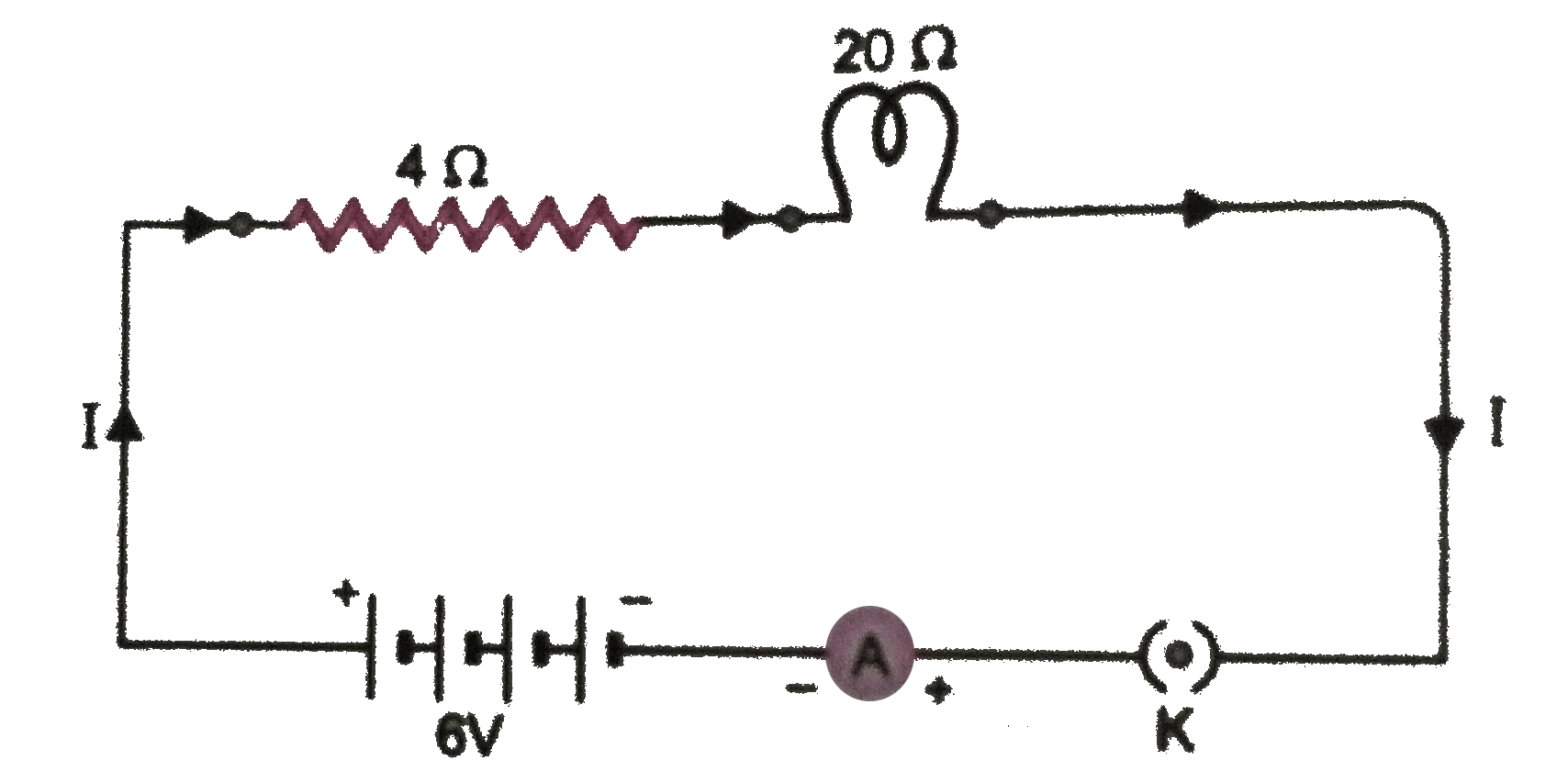An electric lamp, whose resistance is 20 Ω, and a conductor of 4 Ω resistance are connected to a 6 V battery (see figure).
Calculate (a) the total resistance of the circuit, (b) the current through the circuit, and (c ) the potential difference across the electric lamp and conductor.
 Solution in Gujrati
Solution in Gujrati
( a) The resistance of electric lamp, R1=20Ω
The resistance of the conductor connected in series, R2=4Ω
Then the total resistance in the circuit
R=R1+R2
Rs=20Ω+4Ω=24Ω
( b )The total potential difference across the two terminals of the battery
V=6V
Now by the Ohm.s law, the current through the circuit is given by
I=VRa
=6V24Ω
=0.25A
( c )Applying the Ohm.s law to the electric lamp and conductor separately, we get potential difference across the electric lamp,
V1=20Ω×0.25A
=5V
and, that across the conductor,
V2=4Ω×0.25A=1V
Note: Suppose, we like to replace the series combination of electric lamp and conductor by a single and equivalent resistor. Its resistance must be such that a potential difference of 6 V acrosS the battery terminals will cause a current of 0.25 A in the circuit. The resistance R of this equivalent resistor would be
R=VI
=6V/0.25A
=24Ω
This is the total resistance of the series circuit, it is equal to the sum of the two resistances.
Topper's Solved these Questions
- ELECTRICITYBOOK - KUMAR PRAKASHANCHAPTER - ELECTRICITYEXERCISE - QUESTIONS AND ANSWERS (MORE TO KNOW)
1 Video
- ELECTRICITYBOOK - KUMAR PRAKASHANCHAPTER - ELECTRICITYEXERCISE - TEXTUAL EXERCISE
23 Videos
- ELECTRICITYBOOK - KUMAR PRAKASHANCHAPTER - ELECTRICITYEXERCISE - QUESTIONS AND ANSWERS (INTEXT QUESTIONS)
25 Videos
- MAGNETIC EFFECTS OF ELECTRIC CURRENT BOOK - KUMAR PRAKASHANCHAPTER - MAGNETIC EFFECTS OF ELECTRIC CURRENT EXERCISE - VALUE BASED QUESTIONS WITH ANSWERS
15 Videos
Similar Questions
How does a metal conduct electricity ?
View SolutionA piece of wire of resistance R is cut into five equal parts. These parts are then connected in parallel. If the equivalent resistance of this combination is R., then the ratio RR. is ………………. .
View SolutionWhat does an electric circuit mean?
View SolutionShalini and his brother Amey observed a water-pump working , Shalini inquired how an electric motor works . Amey collected different parts of an electric motor e.g., field - magnets , cabon- brushes , armature , battery , switch, connecting wire , split - rings , etc, and showed them to Shalini . Amey then explained how an armature could rotate.
State the principle how an electric motor to works .
View SolutionSuppose a 6-volt battery is connected across lamp whose resistance is 20Ω through a variable resistor as shown in (Fig. 3.11). If the current in the circuit is 0.25A, calculate the value of the resistance from the resistor which must be used ?
 .
.
View SolutionAn electric lamp, whose resistance is 20Ω and a conductor of 4Ω resistance are connected to a 6V battery as shown in (Fig. 3.18) Calculate.
(a) the total resistance of the circuit,
(b) the current through the circuit, and
( c) the potential difference across the electric lamp and the conductor.
 .
.
View Solutionएक विघुत लैम्प जिसका प्रतिरोध 20 है, तथा एक 4Ω प्रतिरोध का चालक 6 V की बैटरी से चित्र 12.9 में दिखाए अनुसार सयोजित हैं। a) परिपथ का कुल प्रतिरोध, b) परिपथ में प्रवाहित विघुत धारा तथा c) विघुत लैम्प तथा चालक के सिरों के बीच विभान्तर परिकलित कीजिये।

View SolutionAs electric lamp and a conductor of resistance 4 Omega are connected in series to a 6 V battery. The current drawn by the lamp is 0.25 A. Find the resistance of the electric lamp.
View SolutionIn an electric circuit, potential difference across a lamp is 20 V and current through the lamp is 0.5A. The resistance of the lamp is
View SolutionAn electric lamp, whose resistance is 20 Omega , and a conductor of 4 Omega resistance are connected to a 6 V battery (Fig. 12.9). Calculate (a) the total resistance of the circuit, (b) the current through the circuit, and (c) the potential difference across the electric lamp and conductor.
View SolutionAn electric lamp whose resistance is 8 Omega and a conductor of 2 Omega resistance are connected in series to a 5 volt battery . Calculate( a) the total resistance of the circuit (b) the current through the circuit (c) the potential difference across the electric lamp and the conductor?
View SolutionAn electric lamp, whose resistance is 20Ω and a conductor of 4Ω resistance are connected to a 6V battery as shown in (Fig. 3.18) Calculate.
(a) the total resistance of the circuit,
(b) the current through the circuit, and
( c) the potential difference across the electric lamp and the conductor.
 .
.
View SolutionAn electric lamp of 24 Ω and a conductor of 6 Ω are connected in parallel to a 12 V battery. Calculate :
(i) Total resistance
(ii) Total current in the circuit
Potential difference across the conductor.
View Solution(a) A current of 1A flows in a series curcuit containing an electric lamp and a conductor of 5Ω when connected to a 10V battery. Calculate the resistance of the electric lamp.
(b) Now if a resistance of 10Ω is connected in parallel with this series combination, what change (if any) in current flowing through 5Ω conductor and potential difference across the lamp will take place ? Give reason.
View SolutionAs electric lamp and a conductor of resistance 4 Omega are connected in series to a 6 V battery. The current drawn by the lamp is 0.25 A. Find the resistance of the electric lamp.
View Solution
